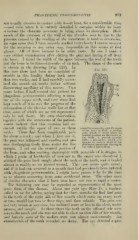Page 963 - My FlipBook
P. 963
PHA GEDENIC PERICEMENTITIS. 973 ;
sue usually remain.s in contact with it—at least, for a considerable time
—and even when it is entirely denuded it contains -within its bony
structure the elements necessary to bring about its absorption. How
much of the eversion of the wall of the alveolus may be due to the
pressure caused by the swelling of the membrane is hard to determine.
In some cases that I have recently studied very closely I cannot account
for the eversion in any other way, impossible as this seems at first
glance. All of these seemed to be acute cases. In one I made a
very critical examination after slitting the gum and laying it off from
the bone. I found the width of the space between the root of the tooth
and the bone to be three-sixteenths of an inch. The shape of the space
is shown in the drawing (Fig. 525). In
Fig. 525.
this case there had been no complaint of
trouble in this locality dating back more
than two Aveeks, and I had carefully exam-
ined the mouth six weeks before without
discovering anything of this nature. Two
years before, I had treated this patient for
phagedenic pericementitis affecting a num-
ber of the u]ipcr teeth, and ever since had
kept watch of it to note the progress of the
reformation of the alveolar walls lost at that
time, some of which are as yet represented
only by soft tissue. My own observation,
together with the statements of the patient,
would indicate that this eversion had oc-
curred within the space of t^'o or three Acute Pericementitis with Eversion
of the Alveolar Wall: a, swollen
weeks. There had been considerable pain gum, which is raised above its
normal position on the crowji of
for about a week ; and when I first saw it,
the tooth; fc, everted alveolar
the gum was inflamed and swollen and pus wall ; c, pus-cavity, which al>o
apiiears to contain fibres of the
Avas discharging freely from under the free peridental membrane clinging to
the wall of the alveolus.
margin. I cut out the everted portion of
the bone, and after washing thoroughly with peroxide of hydrogen in
which 1 grain of bichloride of mercury to the ounce was dissolved I
stitched the gum back snugly about the neck of the tooth, and it healed
almost as readily as an incised wound. This case seems quite novel
and if it had not occurred in a mouth that had previously been infected
with phagedenic pericementitis, I might have passed it by for the time
as an abscess occurring from some accidental cause. The other cases
of similar character that I have seen have not run so rapid a course.
The following case may be regarded as representative of the most
acute form of this disease. About one year ago Miss D., a teacher,
called on me for advice, saying that for three months she had had pain
in the teeth of the right side of her mouth which came on every week
or two, would last two or three days, and then subside. The pain was
not very .severe at any time, but radiated more or less to the cheeh, malar
process, and temple. At these times the teeth on the affected side were
sore to the touch and she was not able to chew on that side of her mouth,
and latterly some of the molars were sore almost continuously. An
examination of the teeth revealed no decay. The eye detected a pro-


